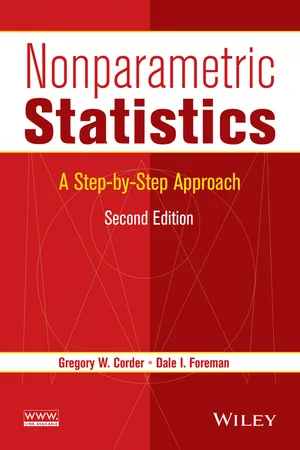
eBook - ePub
Nonparametric Statistics
A Step-by-Step Approach
Gregory W. Corder, Dale I. Foreman
This is a test
- English
- ePUB (adapté aux mobiles)
- Disponible sur iOS et Android
eBook - ePub
Nonparametric Statistics
A Step-by-Step Approach
Gregory W. Corder, Dale I. Foreman
Détails du livre
Aperçu du livre
Table des matières
Citations
À propos de ce livre
"…a very useful resource for courses in nonparametric statistics in which the emphasis is on applications rather than on theory. It also deserves a place in libraries of all institutions where introductory statistics courses are taught." – CHOICE
This Second Edition presents a practical and understandable approach that enhances and expands the statistical toolset for readers. This book includes:
- New coverage of the sign test and the Kolmogorov-Smirnov two-sample test in an effort to offer a logical and natural progression to statistical power
- SPSS® (Version 21) software and updated screen captures to demonstrate how to perform and recognize the steps in the various procedures
- Data sets and odd-numbered solutions provided in an appendix, and tables of critical values
- Supplementary material to aid in reader comprehension, which includes: narrated videos and screen animations with step-by-step instructions on how to follow the tests using SPSS; online decision trees to help users determine the needed type of statistical test; and additional solutions not found within the book.
Foire aux questions
Comment puis-je résilier mon abonnement ?
Il vous suffit de vous rendre dans la section compte dans paramètres et de cliquer sur « Résilier l’abonnement ». C’est aussi simple que cela ! Une fois que vous aurez résilié votre abonnement, il restera actif pour le reste de la période pour laquelle vous avez payé. Découvrez-en plus ici.
Puis-je / comment puis-je télécharger des livres ?
Pour le moment, tous nos livres en format ePub adaptés aux mobiles peuvent être téléchargés via l’application. La plupart de nos PDF sont également disponibles en téléchargement et les autres seront téléchargeables très prochainement. Découvrez-en plus ici.
Quelle est la différence entre les formules tarifaires ?
Les deux abonnements vous donnent un accès complet à la bibliothèque et à toutes les fonctionnalités de Perlego. Les seules différences sont les tarifs ainsi que la période d’abonnement : avec l’abonnement annuel, vous économiserez environ 30 % par rapport à 12 mois d’abonnement mensuel.
Qu’est-ce que Perlego ?
Nous sommes un service d’abonnement à des ouvrages universitaires en ligne, où vous pouvez accéder à toute une bibliothèque pour un prix inférieur à celui d’un seul livre par mois. Avec plus d’un million de livres sur plus de 1 000 sujets, nous avons ce qu’il vous faut ! Découvrez-en plus ici.
Prenez-vous en charge la synthèse vocale ?
Recherchez le symbole Écouter sur votre prochain livre pour voir si vous pouvez l’écouter. L’outil Écouter lit le texte à haute voix pour vous, en surlignant le passage qui est en cours de lecture. Vous pouvez le mettre sur pause, l’accélérer ou le ralentir. Découvrez-en plus ici.
Est-ce que Nonparametric Statistics est un PDF/ePUB en ligne ?
Oui, vous pouvez accéder à Nonparametric Statistics par Gregory W. Corder, Dale I. Foreman en format PDF et/ou ePUB ainsi qu’à d’autres livres populaires dans Mathematik et Wahrscheinlichkeitsrechnung & Statistiken. Nous disposons de plus d’un million d’ouvrages à découvrir dans notre catalogue.
Informations
CHAPTER 1
Nonparametric Statistics: An Introduction
1.1 Objectives
In this chapter, you will learn the following items:
- The difference between parametric and nonparametric statistics.
- How to rank data.
- How to determine counts of observations.
1.2 Introduction
If you are using this book, it is possible that you have taken some type of introductory statistics class in the past. Most likely, your class began with a discussion about probability and later focused on particular methods of dealing with populations and samples. Correlations, z-scores, and t-tests were just some of the tools you might have used to describe populations and/or make inferences about a population using a simple random sample.
Many of the tests in a traditional, introductory statistics text are based on samples that follow certain assumptions called parameters. Such tests are called parametric tests. Specifically, parametric assumptions include samples that
- are randomly drawn from a normally distributed population,
- consist of independent observations, except for paired values,
- consist of values on an interval or ratio measurement scale,
- have respective populations of approximately equal variances,
- are adequately large,* and
- approximately resemble a normal distribution.
If any of your samples breaks one of these rules, you violate the assumptions of a parametric test. You do have some options, however.
You might change the nature of your study so that your data meet the needed parameters. For instance, if you are using an ordinal or nominal measurement scale, you might redesign your study to use an interval or ratio scale. (See Box 1.1 for a description of measurement scales.) Also, you might seek additional participants to enlarge your sample sizes. Unfortunately, there are times when one or neither of these changes is appropriate or even possible.
Box 1.1 Measurement Scales.
We can measure and convey variables in several ways. Nominal data, also called categorical data, are represented by counting the number of times a particular event or condition occurs. For example, you might categorize the political alignment of a group of voters. Group members could either be labeled democratic, republican, independent, undecided, or other. No single person should fall into more than one category.
A dichotomous va...